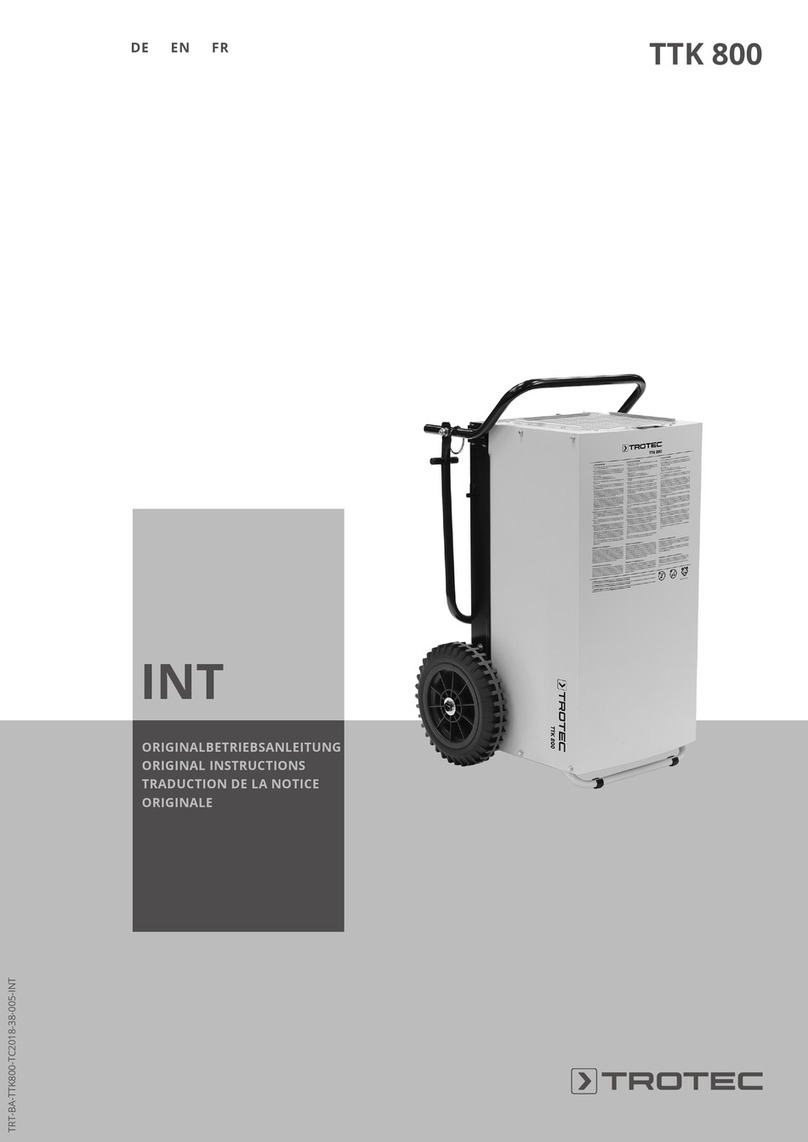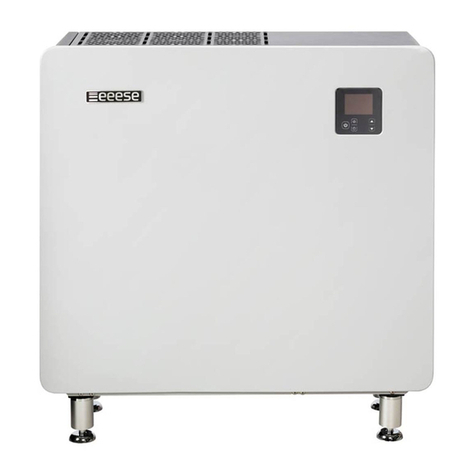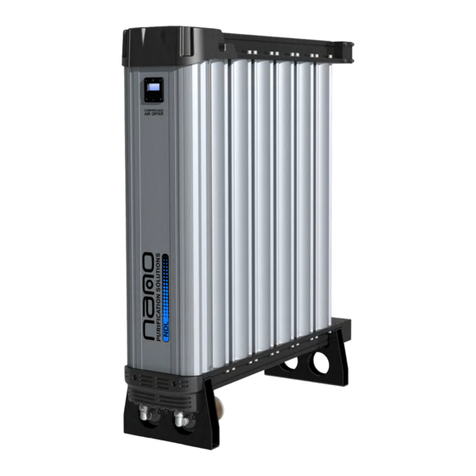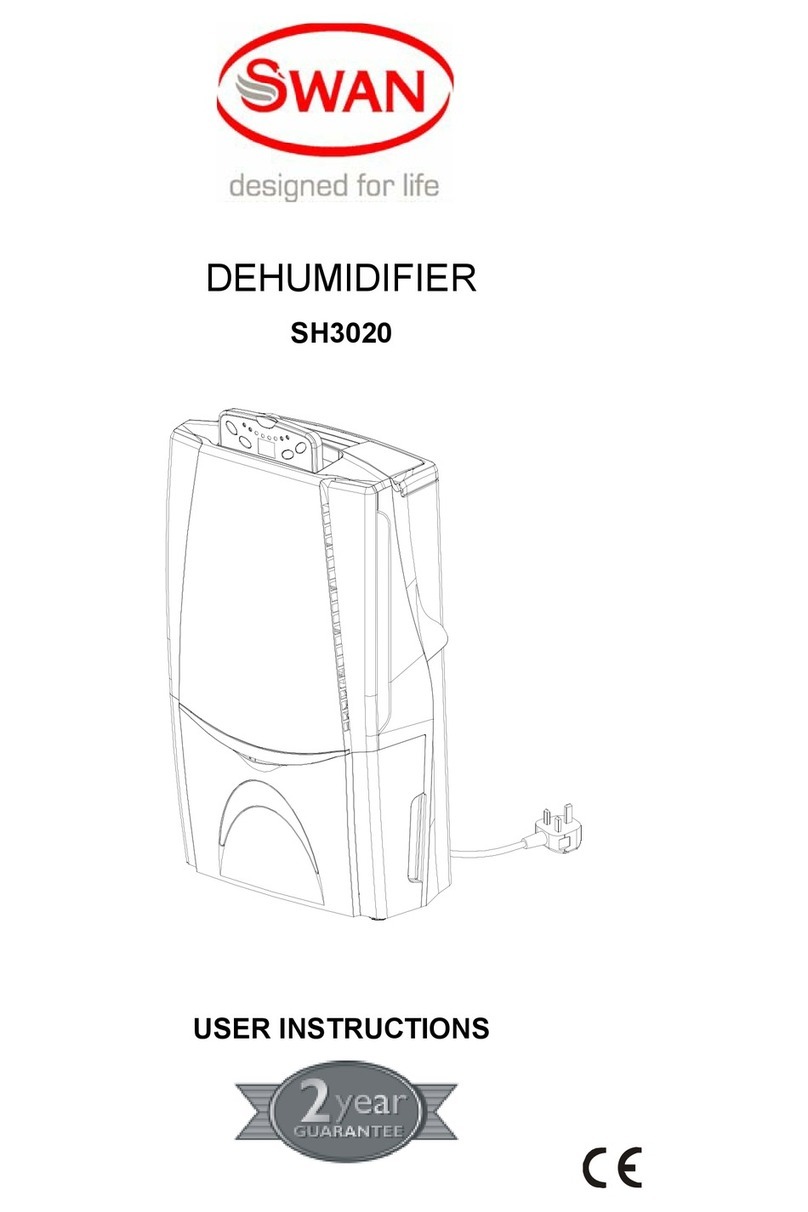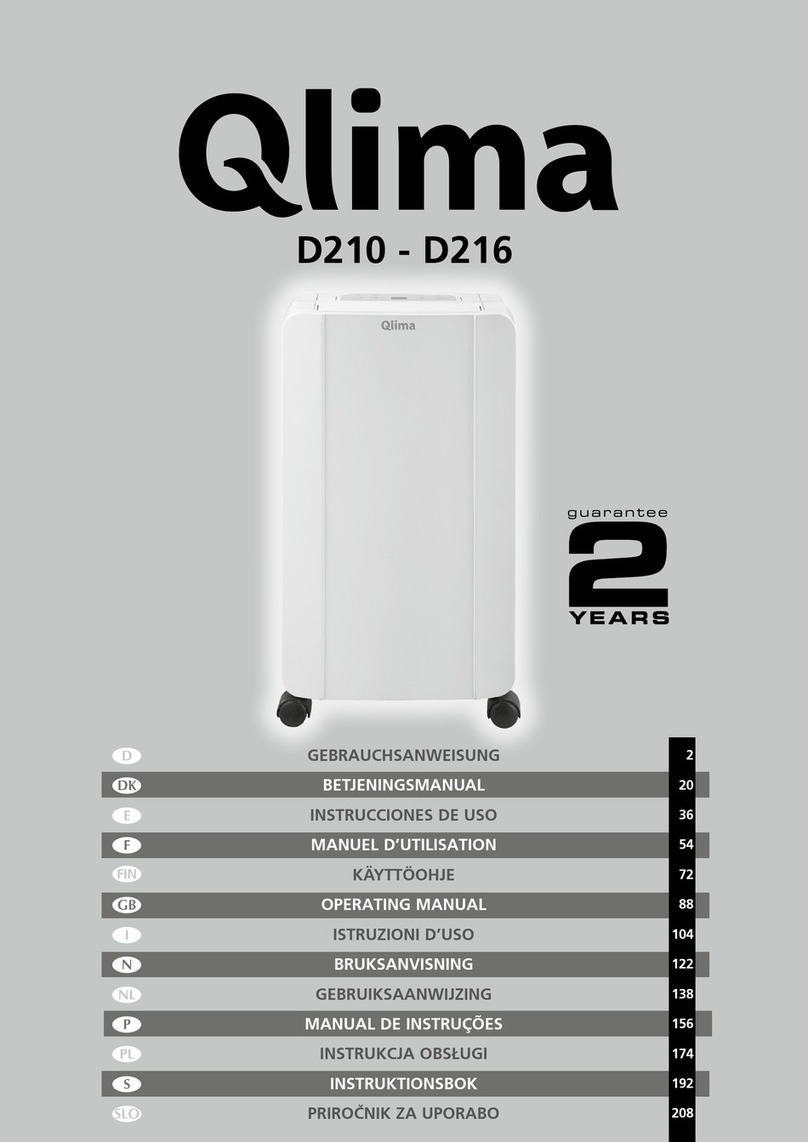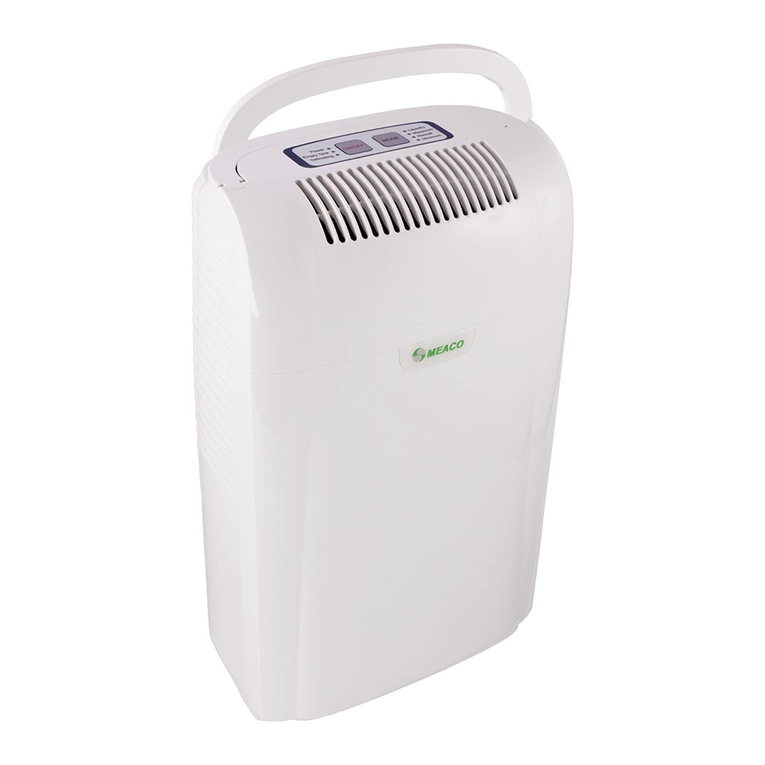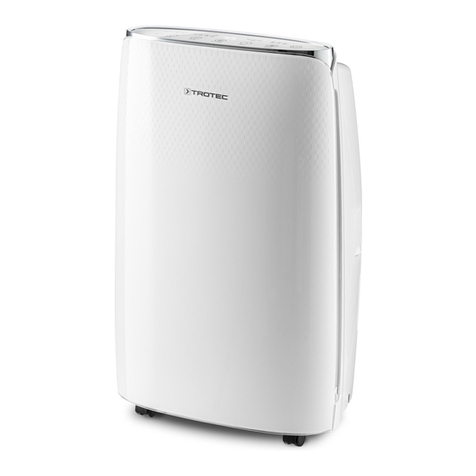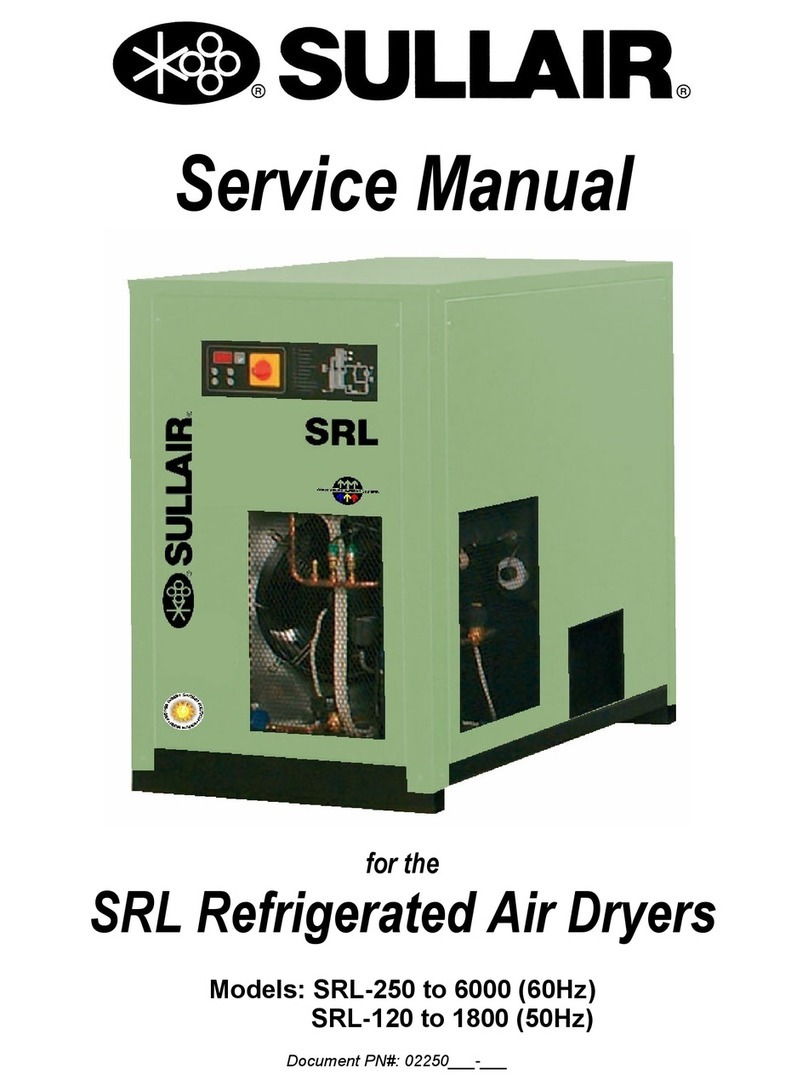Taurus Alpatec PLEASANT User manual

PLEASANT
Deshumidicador
Dehumidier
Déshumidicateur
Entfeuchter
Deumidicatore
Desumidicador
Ontvochtigingsapparaat
Osuszacz powietrza
Αφυγραντήρας
Обезвлажнител
Dezumidicator
Осушитель воздуха

B
CC
D
F
A
G
H
E

A
12345

Español
DESHUMIDIFICADOR
PLEASANT
Por favor, no instale o use su
deshumidicador sin antes haber leído este
manual. Por favor, guarde este manual como
posible garantía de producto y para futuras
referencias.
DESCRIPCIÓN
A Panel de control
B Salida del aire
C Ruedas
D Asas de transporte
E Filtro anti polvo
F Depósito de agua
G Oricio de drenaje
H Manguera de drenaje
Si su modelo no incluye alguno de los componen-
tes descritos anteriormente, se pueden comprar
por separado a través de nuestro Servicio de
Atención Técnica.
USO Y CUIDADO
- Antes de cada uso, desenchufe por completo
el cable de la corriente.
- No utilizar el aparato si el dispositivo de
encendido/apagado no funciona. No mueva el
aparato mientras esté en uso.
- Sacar y vaciar el depósito de agua antes de
mover el aparato. Las salpicaduras podrían da-
ñar partes internas de este deshumidicador.
- Usar las asas de transporte y la ayuda de las
ruedas parar coger o transportar el aparato,
para así evitar lesiones y facilitar el transporte.
- No girar o volcar el aparato mientras esté en
uso o conectado a la corriente.
- Desenchufar el aparato de la corriente eléctri-
ca cuando no esté en uso y antes de llevar al
cabo tareas de limpieza.
- Mantener el aparato lejos del alcance de los
niños y/o personas con discapacidades físicas,
sensoriales, o mentales o que no estén familia-
rizadas con el uso del aparato.
- No exponer el aparato a temperaturas extre-
mas. Nunca deje el aparato desatendido. Esto
le ayudará a ahorrar energía y a prolongar la
vida útil del aparato.
INSTRUCCIONES ANTES DEL
USO
ANTES DEL USO:
- Asegúrese de que ha retirado todo el material
de embalaje del producto.
- Algunas partes del aparato han sido ligera-
mente engrasadas, en consecuencia, al poner
en marcha el aparato por primera vez puede
desprender un ligero humo. Al cabo de poco
tiempo este humo cesará.
- Para eliminar el olor que desprende el aparato
al utilizarlo por primera vez, se recomienda
tenerlo en marcha a máxima potencia durante
2 horas en una habitación bien ventilada.
- Instalar el deshumidicador manteniendo una
distancia de 20cm a su alrededor, con paredes
u otros obstáculos.
INSTALACIÓN DE LAS RUEDAS:
- Colocar el deshumidicador plano en el suelo
con cuidado para poder manipular la base.
- Apretar las ruedas hasta que queden jas.
- Incorporar el deshumidicador de nuevo.
USO:
- Extender completamente el cable antes de
enchufar.
- Enchufar el aparato a la corriente.
- Poner el aparato en marcha pulsando el botón
de encendido /apagado. El piloto luminoso se
encenderá y la pantalla indicará el nivel de
humedad en la habitación.
- Seleccionar la función deseada.
FUNCIONES: PANEL DE
CONTROL
1 Encendido/Apagado
2 Regulador de humedad
3 Pantalla
4 Temporizador
5 Velocidad del ventilador
FUNCIÓN REGULADOR DE HUMEDAD:
- Presionar el botón de regulador de humedad
(2) para iniciar esta función.
- El rango de selección es de ente 40% y 80%.

Cada vez que presione el botón regulador de
la humedad, el porcentaje deseado aumentará
un 5% hasta llegar al máximo de 80%, y luego
volverá a 40%.
- Una vez llegado al % de humedad deseado,
deje de presionar el botón. Al cabo de unos 5
segundos, la pantalla (3) mostrará la humedad
ambiente de nuevo y el piloto luminoso se apa-
gará. Eso signica que la humedad deseada
ha sido jada.
- El aparato operará hasta conseguir una
humedad ambiental 2% por debajo de la se-
leccionada. Al conseguirlo el compresor dejará
de funcionar, pero el ventilador seguirá a la
velocidad escogida.
- Cuando la humedad de la habitación vuelva
a ser 2% superior a la deseada, el compresor
empezará a operar de nuevo.
FUNCIÓN TEMPORIZADOR:
- Esta función se puede utilizar con el deshumi-
dicador encendido o apagado.
- Cuando el deshumidicador está encendido se
puede programar el tiempo de funcionamiento
del compresor.
- Cuando el deshumidicador está apagado se
puede programar el encendido automático del
deshumidicador.
- Presionar el botón del temporizador (4) para
iniciar esta función.
- La pantalla (3) mostrará el tiempo selecciona-
do.
- Ajustar el tiempo deseado presionando el bo-
tón tantas veces como horas quiera programar
(1-24h). Cada vez que presione el botón se
añadirá una hora.
- Al llegar al tiempo deseado, dejar de presionar
el botón. Al cabo de 5 segundos, el tiempo
programado quedará conrmado.
- El piloto luminoso se encenderá.
- Esta función se cancela cuando el deshumidi-
cador se enciende o apaga manualmente o el
depósito de agua se llena.
VELOCIDAD DEL VENTILADOR:
- Presionar el botón de velocidad del ventilador
(5) para seleccionar la velocidad deseada.
- El piloto luminoso le indicará la velocidad
seleccionada.
DRENAJE (DEPÓSITO DE AGUA):
- Cuando el depósito de agua esté lleno, el piloto
luminoso se encenderá. El aparato también
emitirá un sonido para alertar al usuario.
- Cuando esto suceda, el deshumidicador
dejará de funcionar.
- Proceder a sacar el depósito de agua. Poner
una mano en cada lado del depósito, en las
ranuras, para poder sacar el depósito cautelo-
samente.
- Vaciar el depósito.
- Volver a colocar el depósito en el aparato para
reiniciar el deshumidicador.
DRENAJE (DRENAJE CONTINUADO):
- Si preere no vaciar el depósito cada vez que
queda lleno, puede conectar la manguera de
drenaje (H) (de diámetro interior de 10mm) en
el oricio de drenaje (G) para drenar el agua
constantemente.
- Para instalar la manguera, localice el oricio
de drenaje (G), saque el depósito de agua
con cuidado. Proceda a insertar la manguera
alrededor del oricio.
- La parte inferior de la manguera debe quedar
10 cm por debajo del oricio de drenaje.
- La salida de la manguera no debe estar en el
agua. Es altamente recomendable instalar la
manguera en un lugar que permita hacer un
drenaje continuo del agua.
- La manguera no debe tener pliegues, de lo
contrario, podría no drenar correctamente.
UNA VEZ FINALIZADO EL USO DEL
APARATO:
- Parar el aparato presionando el botón de
encendido/apagado (1).
- Desconectar el aparato de la corriente.
- Limpiar el aparato.
ASAS DE TRANSPORTE Y RUEDAS:
- Este deshumidicador lleva asas de trans-
porte en los laterales, que facilitan un cómodo
transporte.
- También lleva cuatro ruedas (C) para facilitar
el transporte del deshumidicador y así evitar
lesiones.
LIMPIEZA
- Desconecte el aparato de la corriente y deje
que se enfríe antes de limpiarlo.

- Limpiar el equipamiento eléctrico y el enchu-
fe con un pañuelo húmedo y sécalos. NO
SUMERGIR EN AGUA O CUALQUIER OTRO
LÍQUIDO.
- Limpiar el aparato con un pañuelo húmedo con
unas pocas gotas de jabón y séquelo.
- No usar disolventes o productos ácidos o bá-
sicos como lejía, u otros productos corrosivos
para limpiar el aparato.
- No permitir que entre agua u otros líquidos en
el interior de la rejilla o las partes interiores del
aparato.
- Nunca sumerja el aparato en agua u otros
líquidos ni lo coloque debajo de agua corriente.
- Si el aparato no se mantiene limpio, su super-
cie podría degradarse y afectar la duración de
la vida útil del producto y podría ser inseguro
de usar.
- Secar todas las partes antes de montar y guar-
dar el aparato.
LIMPIAR EL FILTRO DE AIRE:
- Limpiar el ltro de aire cada 2 semanas. Si
el ltro se bloquea de polvo, su efectividad
quedará reducida.
- Limpiar cuidadosamente con agua tibia y un
detergente neutro y dejar secar por completo
en un lugar seco.
- Instalar el ltro cuidadosamente después del
lavado.

ANOMALÍAS Y
REPARACIONES
Si se detecta una anomalía, compruebe la
siguiente tabla:
Anomalías Posibles causas Solución
El aparato no funciona. ¿Se ha desconectado el
cable de la corriente?
Enchufar el cable a la corriente.
¿El indicador de depósito
lleno está parpadeando? (El
depósito está lleno o en la
posición incorrecta)
Vaciar el agua del depósito y recolo-
carlo correctamente.
¿La temperatura ambiente
está por encima de 35ºC o
por debajo de 5ºC?
El sistema de protección está activa-
do y el deshumidicador no puede
operar.
La función deshumidica-
dora no funciona.
¿El ltro del aire está blo-
queado?
Limpiar el ltro del aire como se
indica en la sección “Limpiar el ltro
del aire”.
¿Las entradas o salidas del
aire están bloqueadas?
Sacar los objetos o partículas que
bloquean la entrada y/o salida del
aire.
No sale aire. ¿El ltro del aire está blo-
queado?
Limpiar el ltro del aire como se
indica en la sección “Limpiar el ltro
del aire”.
El funcionamiento es
ruidoso.
¿El deshumidicador está
inestable?
Mover el deshumidicador a una
supercie plana y estable.
¿El ltro del aire está blo-
queado?
Limpiar el ltro del aire como se
indica en la sección “Limpiar el ltro
del aire”.
El aparato contiene gas refrigerante inammable.

INSTRUCCIONES PARA
LA REPARACIÓN DE
ELECTRODOMÉSTICOS QUE
CONTIENEN R290
INSTRUCCIONES GENERALES
CONTROLES A LA ZONA
-Antes de comenzar a trabajar en sistemas que
contienen refrigerantes inamables, se requie-
ren controles de seguridad para garantizar que
se minimice el riesgo de ignición. Para reparar
el sistema de refrigeración, se deben cumplir
las siguientes precauciones antes de realizar
trabajos en el sistema.
PROCEDIMIENTO DE TRABAJO
- El trabajo se realizará bajo un procedimiento
controlado a n de minimizar el riesgo de pre-
sencia de un gas o vapor inamable mientras
se realiza el trabajo.
ÁREA DE TRABAJO GENERAL
- Todo el personal de mantenimiento y otras
personas que trabajen en el área local recibirán
instrucciones sobre la naturaleza del trabajo
que se está llevando a cabo. Se debe evitar
el trabajo en espacios connados. El área
alrededor del espacio de trabajo se secciona-
rá. Asegúrese de que las condiciones dentro
del área se hayan hecho seguras mediante el
control del material inamable.
COMPROBANDO LA PRESENCIA DE
REFRIGERANTE
- El área debe vericarse con un detector de
refrigerante apropiado antes y durante el
trabajo, para asegurar que el técnico conozca
las atmósferas potencialmente inamables.
Asegúrese de que el equipo de protección con-
tra fugas que se está utilizando sea adecuado
para su uso con refrigerantes inamables, es
decir, antiempañamiento, sellado adecuado o
intrínsecamente seguro.
PRESENCIA DE EXTINTOR
- Si se va a realizar un trabajo en caliente en el
equipo de refrigeración o en cualquier pieza
asociada, se debe tener a mano un equipo
apropiado para extinguir el fuego. Tenga un
extintor de polvo seco o CO2 adyacente al área
de carga.
SIN FUENTES DE IGNICIÓN
- Ninguna persona que realice un trabajo en
relación con un sistema de refrigeración que
implique exponer cualquier trabajo de tubería
que contenga o haya contenido refrigerante
inamable deberá utilizar cualquier fuente de
ignición de forma que pueda ocasionar un
incendio o una explosión. Todas las posibles
fuentes de ignición, incluido el tabaquismo,
deben mantenerse lo sucientemente lejos
del sitio de instalación, reparación, eliminación
y eliminación, durante el cual es posible que
se libere refrigerante inamable en el espacio
circundante. Antes de que se lleve a cabo el
trabajo, se debe inspeccionar el área alrededor
del equipo para asegurarse de que no haya
peligros inamables ni riesgos de ignición. Los
letreros de “No Fumar” serán desplegados.
ÁREA VENTILADA
- Asegúrese de que el área esté abierta o
que esté adecuadamente ventilada antes de
ingresar al sistema o realizar cualquier trabajo
en caliente. Un grado de ventilación continuará
durante el período en que se realice el trabajo.
La ventilación debe dispersar con seguridad
cualquier refrigerante liberado y preferiblemen-
te expulsarlo externamente a la atmósfera.
CONTROLES AL EQUIPO DE
REFRIGERACIÓN
- Cuando se cambien componentes eléctricos,
deberán ser aptos para el propósito y la espe-
cicación correcta. En todo momento se deben
seguir las pautas de mantenimiento y servicio
del fabricante. En caso de duda, consulte al
departamento técnico del fabricante para obte-
ner asistencia. Las siguientes comprobaciones
se aplicarán a las instalaciones que utilizan
refrigerantes inamables: el tamaño de la carga
está de acuerdo con el tamaño de la habitación
en la que se instalan las piezas que contienen
refrigerante; la maquinaria de ventilación y las
salidas funcionan correctamente y no están
obstruidas; si se utiliza un circuito de refrige-
ración indirecto, se debe vericar la presencia
de refrigerante en el circuito secundario; el
marcado en el equipo continúa siendo visible
y legible. Marcas y signos que son ilegibles
deben ser corregidos; Las tuberías o compo-
nentes de refrigeración están instalados en una
posición en la que es poco probable que estén
expuestos a cualquier sustancia que pueda co-
rroer el componente que contiene refrigerantes,
a menos que los componentes estén construi-
dos con materiales que sean intrínsecamente

resistentes a la corrosión o que estén adecua-
damente protegidos contra la corroción.
CONTROLES A DISPOSITIVOS ELÉCTRICOS
- La reparación y el mantenimiento de los
componentes eléctricos deben incluir contro-
les de seguridad iniciales y procedimientos
de inspección de componentes. Si existe una
falla que podría comprometer la seguridad,
entonces no se deberá conectar ningún sumi-
nistro eléctrico al circuito hasta que no se haya
solucionado satisfactoriamente. Si la falla no se
puede corregir de inmediato, pero es necesario
continuar con la operación, se debe usar una
solución temporal adecuada. Esto se informará
al propietario del equipo para que se notique a
todas las partes.
- Las vericaciones de seguridad iniciales deben
incluir: que los condensadores estén descar-
gados: esto debe hacerse de manera segura
para evitar la posibilidad de chispas; que no
hay cables y componentes eléctricos activos
expuestos durante la carga, recuperación o
purga del sistema; que hay continuidad de la
vinculación de la tierra.
REPARACIONES DE COMPONENTES
SELLADOS
- Durante las reparaciones de los componentes
sellados, todos los suministros eléctricos deben
desconectarse del equipo que se está trabajan-
do antes de retirar las cubiertas selladas, etc.
Si es absolutamente necesario tener un sumi-
nistro eléctrico al equipo durante el servicio,
entonces una forma de funcionamiento perma-
nente de La detección de fugas se debe ubicar
en el punto más crítico para advertir sobre una
situación potencialmente peligrosa.
- Se deberá prestar especial atención a lo
siguiente para garantizar que, al trabajar con
componentes eléctricos, la carcasa no se
modique de forma que se vea afectado el
nivel de protección. Esto debe incluir daños a
los cables, un número excesivo de conexio-
nes, terminales no hechas a la especicación
original, daños a las juntas, ajuste incorrecto
de los prensaestopas, etc. Asegúrese de que
el aparato esté montado de forma segura.
Asegúrese de que las juntas o los materiales
de sellado no se hayan degradado de manera
que ya no sirvan para prevenir la entrada de
atmósferas inamables. Las piezas de repuesto
deben estar de acuerdo con las especicacio-
nes del fabricante.
- NOTA El uso de sellador de silicio puede inhibir
la efectividad de algunos tipos de equipos de
detección de fugas. Los componentes intrín-
secamente seguros no tienen que ser aislados
antes de trabajar en ellos.
REPARACIÓN DE COMPONENTES
INTRÍNSECAMENTE SEGUROS
- No aplique cargas inductivas o de capacitancia
permanentes al circuito sin asegurarse de que
esto no exceda el voltaje y la corriente permi-
tidos para el equipo en uso.
- Los componentes intrínsecamente seguros
son los únicos tipos en los que se puede
trabajar mientras se vive en presencia de una
atmósfera inamable. El aparato de prueba
debe tener la calicación correcta. Reemplace
los componentes solo con partes especicadas
por el fabricante. Otras partes pueden provocar
la ignición de refrigerante en la atmósfera por
una fuga.
CABLEADO
- Verique que el cableado no esté sujeto a
desgaste, corrosión, presión excesiva, vi-
bración, bordes alados o cualquier otro efecto
ambiental adverso. La vericación también
tendrá en cuenta los efectos del envejecimiento
o la vibración continua de fuentes tales como
compresores o ventiladores.
DETECCIÓN DE REFRIGERANTES
INFLAMABLES.
- Bajo ninguna circunstancia se deberán usar fu-
entes de ignición potenciales en la búsqueda o
detección de fugas de refrigernate. Ne se debe
usar una antorcha de haluro (o cualquier otro
detector que use una llama desnuda).
MÉTODOS DE DETECCIÓN DE FUGAS
- Los siguientes métodos de detección de fugas
se consideran aceptables para los sistemas
que contienen refrigerantes inamables. Se
deben usar detectores electrónicos de fugas
para detectar refrigerantes inamables, pero
la sensibilidad puede no ser adecuada o
puede requerir una recalibración. (El equipo
de detección se debe calibrar en un área sin
refrigerante). Asegúrese de que el detector
no sea una fuente de ignición potencial y
sea adecuado para el refrigerante utilizado.
El equipo de detección de fugas se ajustará
a un porcentaje del LFL del refrigerante y se
calibrará con el refrigerante empleado y se
conrmará el porcentaje apropiado de gas
(máximo del 25%). Los uidos de detección de
fugas son adecuados para usar con la mayoría
de los refrigerantes, pero se debe evitar el uso

de detergentes que contengan cloro, ya que
el cloro puede reaccionar con el refrigerante y
corroer las tuberías de cobre. Si se sospecha
una fuga, todas las llamas desnudas deben ser
eliminadas / extinguidas. Si se encuentra una
fuga de refrigerante que requiere soldadura
fuerte, todo el refrigerante debe ser recuperado
del sistema o aislado (por medio de válvulas
de cierre) en una parte del sistema alejada de
la fuga. El nitrógeno libre de oxígeno (OFN) se
debe purgar a través del sistema antes y duran-
te el proceso de soldadura fuerte.
EXTRACCIÓN Y EVACUACIÓN
- Cuando se rompa en el circuito de refrigerante
para realizar reparaciones, o para cualquier
otro propósito, se deben usar procedimientos
convencionales. Sin embargo, es importante
que se sigan las mejores prácticas ya que la
inamabilidad es una consideración. Se debe
cumplir el siguiente procedimiento: eliminar el
refrigerante; purgar el circuito con gas inerte;
evacuar; purgar de nuevo con gas inerte; abra
el circuito cortando o soldando.La carga de
refrigerante se recuperará en los cilindros de
recuperación correctos. El sistema se „purgará”
con OFN para hacer que la unidad sea segura.
Este proceso puede necesitar repetirse varias
veces. El aire comprimido u oxígeno no se
debe usar para esta tarea. El enjuague debe
lograrse rompiendo el vacío en el sistema con
OFN y continua llenándose hasta que se logre
la presión de trabajo, luego se expulse a la
atmósfera y nalmente se reduzca al vacío.
Este proceso se repetirá hasta que no haya
refrigerante dentro del sistema. Cuando se
utiliza la carga nal de OFN, el sistema debe
descargarse a la presión atmosférica para
permitir que se lleve a cabo el trabajo. Esta
operación es absolutamente vital si se van a
realizar operaciones de soldadura fuerte en la
tubería. Asegúrese de que la salida de la bom-
ba de vacío no esté cerca de ninguna fuente de
ignición y que haya ventilación disponible.
PROCEDIMIENTOS DE CARGA
- Además de los procedimientos de carga
convencionales, se deben seguir los siguientes
requisitos.
- Asegúrese de que no haya contaminación de
diferentes refrigerantes cuando utilice el equipo
de carga. Las mangueras o líneas deben ser lo
más cortas posible para minimizar la cantidad
de refrigerante que contienen.
- Los cilindros deben mantenerse en posición
vertical.
- Asegúrese de que el sistema de refrigeración
esté conectado a tierra antes de cargar el siste-
ma con refrigerante.
- Etiquete el sistema cuando la carga esté com-
pleta (si no es así).
- Se debe tener extremo cuidado de no sobrelle-
nar el sistema de refrigeración.
- Antes de recargar el sistema, se someterá a
prueba de presión con OFN. El sistema se
probará contra fugas al nalizar la carga, pero
antes de la puesta en marcha. Se debe realizar
una prueba de fuga de seguimiento antes de
abandonar el sitio.
DESMANTELAMIENTO
- Antes de llevar a cabo este procedimiento, es
esencial que el técnico esté completamente
familiarizado con el equipo y todos sus detalles.
Se recomienda como buena práctica que todos
los refrigerantes se recuperen de manera
segura. Antes de llevar a cabo la tarea, se
tomará una muestra de aceite y refrigerante en
caso de que se requiera un análisis antes de
la reutilización del refrigerante regenerado. Es
esencial que la energía eléctrica esté disponi-
ble antes de comenzar la tarea.
a) Familiarizarse con el equipo y su funciona-
miento.
b) Aislar el sistema eléctricamente.
c) Antes de intentar el procedimiento, asegúrese
de que: el equipo de manejo mecánico esté
disponible, si es necesario, para el manejo
de cilindros de refrigerante; todo el equipo de
protección personal está disponible y se usa
correctamente; el proceso de recuperación
es supervisado en todo momento por una
persona competente; Los equipos y cilindros
de recuperación cumplen con los estándares
apropiados.
d) Bombee el sistema de refrigerante, si es
posible.
e) Si no es posible el vacío, haga un colector
para que el refrigerante se pueda extraer de
varias partes del sistema.
f) Asegúrese de que el cilindro esté situado en la
báscula antes de que tenga lugar la recupe-
ración.
g) Arranque la máquina de recuperación y opere
de acuerdo con las instrucciones del fabri-
cante.

h) No llene demasiado los cilindros. (No más del
80% de carga líquida de volumen).
i) No exceda la presión máxima de trabajo del
cilindro, aunque sea temporalmente.
j) Cuando los cilindros se hayan llenado correc-
tamente y se haya completado el proceso,
asegúrese de que los cilindros y el equipo
se retiren del sitio de inmediato y que todas
las válvulas de aislamiento del equipo estén
cerradas.
k) El refrigerante recuperado no debe cargarse
en otro sistema de refrigeración a menos que
haya sido limpiado y vericado.
ETIQUETADO
- El equipo debe estar etiquetado indicando que
ha sido desactivado y vaciado del refrigerante.
La etiqueta deberá estar fechada y rmada.
- Asegúrese de que haya etiquetas en el equipo
que indiquen que el equipo contiene refrigeran-
te inamable.
RECUPERACIÓN
- Cuando se retira el refrigerante de un sistema,
ya sea para el mantenimiento o la clausura,
se recomienda una buena práctica para que
todos los refrigerantes se eliminen de manera
segura. Al transferir refrigerante a los cilindros,
asegúrese de que solo se empleen cilindros
de recuperación de refrigerante apropiados.
Asegúrese de que esté disponible la cantidad
correcta de cilindros para retener la carga
total del sistema. Todos los cilindros que se
utilizarán están diseñados para el refrigerante
recuperado y etiquetados para ese refrigerante
(es decir, cilindros especiales para la recuper-
ación de refrigerante). Los cilindros deben estar
completos con válvula de alivio de presión y
válvulas de cierre asociadas en buen estado de
funcionamiento. Los cilindros de recuperación
vacíos se evacuan y, si es posible, se enfrían
antes de que se produzca la recuperación.
- El equipo de recuperación debe estar en buen
estado de funcionamiento con un conjunto de
instrucciones relativas al equipo que se tiene
a mano y debe ser adecuado para la recuper-
ación de refrigerantes inamables. Además,
debe haber un juego de balanzas calibradas
disponible y en buen estado de funcionami-
ento. Las mangueras deben estar completas
con acoplamientos de desconexión libres de
fugas y en buenas condiciones. Antes de usar
la máquina de recuperación, verique que esté
en buen estado de funcionamiento, que se
haya mantenido adecuadamente y que todos
los componentes eléctricos asociados estén
sellados para evitar el encendido en caso de
que se libere refrigerante. Consulte al fabrican-
te si tiene dudas.
- El refrigerante recuperado se devolverá al
proveedor de refrigerante en el cilindro de
recuperación correcto y se colocará la Nota de
transferencia de residuos correspondiente. No
mezcle refrigerantes en unidades de recuper-
ación y especialmente no en cilindros.
- Si los compresores o aceites del compresor
deben ser removidos, asegúrese de que hayan
sido evacuados a un nivel aceptable para
asegurarse de que el refrigerante inamable no
permanezca dentro del lubricante. El proce-
so de evacuación se llevará a cabo antes de
devolver el compresor a los proveedores. Para
acelerar este proceso, solo debe emplearse
calefacción estéctrica en el cuerpo del compre-
sor. Cuando se extrae el aceite de un sistema,
debe llevarse a cabo de manera segura.
COMPETENCIA DEL
PERSONAL DE SERVICIO
GENERAL
- Se requiere capacitación especial adicional a
los procedimientos habituales de reparación de
equipos de refrigeración cuando el equipo con
refrigerantes inamables se ve afectado.
- En muchos países, esta capacitación se lleva
a cabo por organizaciones nacionales de ca-
pacitación que están acreditadas para enseñar
las normas de competencia nacional relevantes
que pueden establecerse en la legislación.
- La competencia lograda debe estar documen-
tada por un certicado.
FORMACIÓN
- La capacitación debe incluir el contenido de lo
siguiente:
- Información sobre el potencial de explosión de
refrigerantes inamables para demostrar que
los productos inamables pueden ser peligro-
sos si se manipulan sin cuidado.
- Información sobre posibles fuentes de ignición,
especialmente aquellas que no son obvias,
como encendedores, interruptores de luz, aspi-
radoras, calentadores eléctricos.
- Información sobre los diferentes conceptos de
seguridad:
- Sin ventilación - (ver Cláusula GG.2) La seguri-

dad del aparato no depende de la ventilación
de la carcasa. La desconexión del aparato o la
apertura de la carcasa no tiene ningún efecto
signicativo en la seguridad. Sin embargo, es
posible que se acumule refrigerante con fugas
dentro del gabinete y se liberará una atmósfera
inamable cuando se abra el gabinete.
- Recinto ventilado - (ver Cláusula GG.4) La se-
guridad del artefacto depende de la ventilación
de la carcasa. La desconexión del aparato o la
apertura del armario tiene un efecto signicati-
vo en la seguridad. Se debe tener cuidado para
garantizar una ventilación suciente antes.
- Sala ventilada - (ver Cláusula GG.5) La seguri-
dad del aparato depende de la ventilación de
la habitación. La desconexión del aparato o la
apertura de la carcasa no tiene ningún efecto
signicativo en la seguridad. La ventilación de
la habitación no se desconectará durante los
procedimientos de reparación.
- Información sobre el concepto de componentes
sellados y envolventes sellados según IEC
60079-15: 2010.
- Información sobre los procedimientos de traba-
jo correctos:
PUESTA EN SERVICIO
- Asegúrese de que el área del piso sea suci-
ente para la carga de refrigerante o de que el
conducto de ventilación esté ensamblado de la
manera correcta.
- Conecte las tuberías y realice una prueba de
fugas antes de cargar el refrigerante.
- Verique el equipo de seguridad antes de
ponerlo en servicio.
MANTENIMIENTO
- El equipo portátil debe repararse en el exterior
o en un taller especialmente equipado para
reparar unidades con refrigerantes inamables.
- Asegure suciente ventilación en el lugar de
reparación.
- Tenga en cuenta que el mal funcionamiento del
equipo puede ser causado por la pérdida de
refrigerante y es posible que haya una fuga de
refrigerante.
- Descargue los condensadores de manera
que no provoquen chispas. El procedimiento
estándar para cortocircuitar los terminales del
condensador generalmente crea chispas.
- Vuelva a armar los armarios sellados con
precisión. Si los sellos están desgastados,
reemplácelos.
- Verique el equipo de seguridad antes de
ponerlo en servicio.
REPARAR
- El equipo portátil debe repararse en el exterior
o en un taller especialmente equipado para
reparar unidades con refrigerantes inamables.
- Asegure suciente ventilación en el lugar de
reparación.
- Tenga en cuenta que el mal funcionamiento del
equipo puede ser causado por la pérdida de
refrigerante y es posible que haya una fuga de
refrigerante.
- Descargue los condensadores de manera que
no provoquen chispas.
- Cuando se requiera soldadura fuerte, los sigu-
ientes procedimientos se llevarán a cabo en el
orden correcto:
- Retire el refrigerante. Si las regulaciones
nacionales no requieren la recuperación, drene
el refrigerante hacia el exterior. Tenga cuidado
de que el refrigerante drenado no cause ningún
peligro. En la duda, una persona debe guardar
la salida. Tenga especial cuidado de que el re-
frigerante drenado no ote nuevamente dentro
del edicio.
- Evacuar el circuito de refrigerante.
- Purgue el circuito de refrigerante con nitrógeno
durante 5 minutos.
- Evacuar nuevamente.
- Retire las piezas que se reemplazarán cortan-
do, no por llama.
- Purgue el punto de soldadura con nitrógeno
durante el procedimiento de soldadura fuerte.
- Realice una prueba de fugas antes de cargar
refrigerante.
- Vuelva a armar los armarios sellados con
precisión. Si los sellos están desgastados,
reemplácelos.
- Verique el equipo de seguridad antes de
ponerlo en servicio.
DESMANTELAMIENTO
- Si la seguridad se ve afectada cuando el
equipo se pone fuera de servicio, la carga
de refrigerante deberá eliminarse antes de la
clausura.
- Asegure una ventilación suciente en la ubica-
ción del equipo.
- Tenga en cuenta que el mal funcionamiento del
equipo puede ser causado por la pérdida de
refrigerante y es posible que haya una fuga de
refrigerante.
- Descargue los condensadores de manera que
no provoquen chispas.
- Retire el refrigerante. Si las regulaciones

nacionales no requieren la recuperación, drene
el refrigerante hacia el exterior. Tenga cuidado
de que el refrigerante drenado no cause ningún
peligro. En la duda, una persona debe guardar
la salida. Tenga especial cuidado de que el re-
frigerante drenado no ote nuevamente dentro
del edicio.
- Evacuar el circuito de refrigerante.
- Purgue el circuito de refrigerante con nitrógeno
durante 5 minutos.
- Evacuar nuevamente.
- Llene con nitrógeno hasta la presión atmosféri-
ca.
- Coloque una etiqueta en el equipo que indique
que se retiró el refrigerante.
ELIMINACIÓN
- Asegurar una ventilación suciente en el lugar
de trabajo.
- Retire el refrigerante. Si las regulaciones
nacionales no requieren la recuperación, drene
el refrigerante hacia el exterior. Tenga cuidado
de que el refrigerante drenado no cause ningún
peligro. En la duda, una persona debe guardar
la salida. Tenga especial cuidado de que el re-
frigerante drenado no ote nuevamente dentro
del edicio.
- Evacuar el circuito de refrigerante.
- Purgue el circuito de refrigerante con nitrógeno
durante 5 minutos.
- Evacuar nuevamente.
- Cortar el compresor y drenar el aceite.
TRANSPORTE, MARCADO Y
ALMACENAMIENTO PARA UNIDADES QUE
EMPLEAN REFRIGERANTES INFLAMABLES
TRANSPORTE DE EQUIPOS QUE
CONTIENEN REFRIGERANTES
INFLAMABLES
- Se llama la atención sobre el hecho de que
pueden existir regulaciones de transporte adici-
onales con respecto a los equipos que contie-
nen gases inamables. La cantidad máxima de
equipos o la conguración del equipo, que se
permite transportar juntos, estará determinada
por las normas de transporte aplicables.
MARCADO DE EQUIPOS CON SIGNOS
- Los avisos de electrodomésticos similares que
se usan en un área de trabajo generalmente
son tratados por las reglamentaciones locales y
brindan los requisitos mínimos para la provisión
de señales de seguridad y / o de salud para un
lugar de trabajo.
- Se deben mantener todos los letreros requ-
eridos y los empleadores deben asegurarse
de que los empleados reciban instrucción y
capacitación adecuada y suciente sobre el
signicado de las señales de seguridad apro-
piadas y las acciones que deben tomarse en
relación con estas señales.
- La efectividad de los signos no debe verse
disminuida por demasiados signos que se
colocan juntos.
- Cualquier pictograma utilizado debe ser lo
más simple posible y contener solo detalles
esenciales.
ELIMINACIÓN DE EQUIPOS QUE UTILIZAN
REFRIGERANTES INFLAMABLES
- Ver regulaciones nacionales.
ALMACENAMIENTO DE EQUIPOS /
ELECTRODOMÉSTICOS
- El almacenamiento del equipo debe estar de
acuerdo con las instrucciones del fabricante.
- Almacenamiento de equipos empacados (sin
vender)
- La protección del paquete de almacenamiento
debe estar construida de tal manera que el
daño mecánico al equipo dentro del paquete no
cause una fuga de la carga de refrigerante.
- La cantidad máxima de equipos permitidos
para almacenarse juntos será determinado por
las regulaciones locales.

English
DEHUMIDIFIER
PLEASANT
Please do not install or use your
dehumidier before you have carefully read this
manual. Please keep this instructions manual for
an eventual product warranty and for future
reference.
DESCRIPTION
A Control panel
B Air outlet
C Casters
D Handle
E Air lter
F Water tank
G Drainage outlet
H Drainage hose
If the model of your appliance does not have the
accessories described above, they can also be
bought separately from the Technical Assistance
Service.
USE AND CARE:
- Before each use, completely unplug the power
cable from the power supply.
- Do not use the appliance if its start / stop
device does not work. Do not remove the legs
from the appliance. Do not move the appliance
while it is in use.
- Remove and empty the water tank before mo-
ving the appliance. Water spill could damage
interal parts of this dehumidier
- Use the handle and the assistance of the
casters to take or transport the appliance in
order to avoid injuries and facilitate the trans-
portation.
- Do not turn the appliance over while it is in use
or connected to the mains.
- Unplug the power supply from the mains when
not in use and before performing any cleaning
operations.
- Keep this appliance out of the reach of children
and / or persons with reduced physical, senso-
ry or mental abilities or who are unfamiliar with
its use.
- Do not expose the appliance to extreme tem-
peratures. Keep the device in a dry, dust-free
place protected from direct sunlight. Never lea-
ve the appliance unattended. It will also save
energy and prolong the life of the device.
INSTRUCTIONS FOR USE
BEFORE USE:
- Make sure that all products’ packaging has
been removed.
- Some parts of the appliance have been lightly
greased. Consequently, the rst time the ap-
pliance is used a light smoke may be detected.
After a short time, this smoke will disappear.
- To eliminate the smell given off by the applian-
ce when used for the rst time, it is recommen-
ded to have it on at full power for 2 hours in a
well-ventilated room.
- Install the dehumidier maintaining a clearance
space of 20cm around the unit from walls or
other obstacles.
CASTERS INSTALLATION:
- Carefully place the dehumidier at on the
ground in order to easily handle the base of the
appliance.
- Fasten them until they are locked in.
- Place the dehumidier upright again.
USE:
- Extend the cable completely before plugging
it in.
- Plug the appliance into the mains.
- Turn the appliance on, by using the on/off
button. The power light indicator will turn on
and the display will indicate the humidity level
in the room.
- Select the desired function.
FAN FUNCTION: CONTROL
PANEL
1 Power
2 Humidity setting
3 Display
4 Timer
5 Fan speed

HUMIDITY SETTING FUNCTION:
- Press the humidity setting button (2) to initiate
this function.
- The humidiy range is 40% to 80%. Every time
you press the button the humidity %, shown on
the display, will increase by 5% until reaching
the maximum of 80%, and then it will go back
to 40%.
- Once you have reached the desired humidity
%, stop pressing the button. After around 5
seconds, the display (3) will show the ambient
humidity again and the pilot light will turn off.
That means the desired humidity has been set.
- The appliance will run until the room’s humidity
reaches 2% lower than the one chosen. The
compressor will stop but the fan will keep run-
ning at the set speed.
- When the ambient humidity is 2% higher than
the selected humidity level, the compressor will
start again.
TIMER FUNCTION:
- This function can be used when the dehumidi-
er is on or in stand by mode.
- When the dehumidier is on, the running time
of the compressor can be programmed.
- When the dehumidier is off, it can be pro-
grammed to automatically turn on after the set
time.
- Press the timer button (4) to iniciate this func-
tion.
- The display screen (3) will show the time that is
selected.
- Adjust the desired time by pressing the button
as many times as hours needed (1-24h). Every
press adjusts one hour.
- Once you reach the desired time, stop pressing
the button. After ve seconds, the set time is
conrmed.
- The light indicator above will turn on.
- This function will be cancelled when the dehu-
midier is manually switched on/off, or when
the water tank is full.
FAN SPEED:
- Select the desired fan speed (high or low) by
pressing the fan speed button (5).
- The pilot light will indicate which speed is
selected.
DRAINAGE (WATER TANK):
- When the water tank is full, the full tank light
indicator will turn on. The appliance also emits
a buzzing sound to alert the user.
- When the water tank is full, the operation will
stop.
- Proceed to remove the water tank. Place one
hand on each side of the depression areas to
gently remove the water tank.
- Pour the water out.
- Proceed to place the tank back into the appli-
ance to restart the dehumidier.
DRAINAGE (CONTINUOUS DRAINAGE):
- If you do not want to empty the water tank ever-
ytime it gets full, you can connect the drainage
pipe provided (H) (inner diameter 10mm) to the
drainage outlet (G) to drain the water continu-
ously.
- To install the pipe, locate the drain outlet (G),
remove the water tank carefully and pull out
the drain cover. Proceed to connect the 10mm
drainage pipe to the outlet.
- The low end of the water pipe must be more
than 10cm lower than the height of the water
outlet.
- The end of the pipe cannot remain in water. It is
highly recommended to install it on a place that
allows the water to drain constantly.
- The water pipe must be kept smooth, otherwise
the water may not be drained properly.
ONCE THE APPLIANCE HAS BEEN USED:
- Stop the appliance pressing the on/off button
(1).
- Unplug the appliance from the mains.
- Clean the appliance.
CARRY HANDLES AND CASTERS:
- This appliance has handles on the side of the
body, which facilitates comfortable transport
(D).
- There are also four casters (C) to facilitate
the transportation of the appliance and avoid
injuries.
CLEANING
- Disconnect the appliance from the mains and
allow it to cool before undertaking any cleaning
task.

- Clean the electrical equipment and the mains
connection with a damp cloth and dry. DO
NOT IMMERSE IN WATER OR ANY OTHER
LIQUID.
- Clean the equipment with a damp cloth with a
few drops of washing-up liquid and then dry.
- Do not use solvents, or products with an acid or
base pH such as bleach, or abrasive products,
for cleaning the appliance.
- Do not let water or any other liquid get into the
air vents to avoid damage to the inner parts of
the appliance.
- Never submerge the appliance in water or any
other liquid or place it under running water.
- If the appliance is not in good condition of
cleanliness, its surface may degrade and
inexorably affect the duration of the appliance’s
useful life and could become unsafe to use.
- Then dry all parts before its assembly and
storage.
CLEANING THE AIR FILTER:
- Clean the air lters every 2 weeks. If the air
lter is blocked with dust, its effectiveness will
be reduced.
- Wash the air lter by submerging it carefully
in warm water with a neutral detergent, rinse
them off and let them dry completely in a shady
place.
- Install the lters carefully after having them
cleaned ant completely dry.

ANOMALIES AND REPAIR
- If any anomaly is detected, check the following
table:
Anomalies Possible Cause Solution
The unit doesn't operate. Has the power cord been
disconnected?
Plug the power cord into the outlet.
Is the tank full indication
lamp blinking? (The tank is
full or in a wrong position.)
Empty the water in the drainage tank
and then reposition the tank.
Is the temperature of the
room above 35ºC or below
5ºC?
The protection device is
activated and the unit
cannot be started.
The dehumidifying
function doesn't work
Is the air lter clogged? Clean the air lter as
instructed under the section
"Cleaning the air lter".
Is the intake duct or
discharge duct obstructed?
Remove the obstruction from the
discharge duct or intake duct.
No air is discharged Is the air lter clogged? Clean the air lter as
instructed under the section
"Cleaning the air lter".
Operation is noisy Is the unit tilted or
unsteady?
Move the unit to a stable, sturdy
location.
Is the air lter clogged? Clean the air lter as
instructed under the section
"Cleaning the air lter".
The appliance contains ammable refrigerant

INSTRUCTIONS FOR
REPAIRING APPLIANCES
CONTAINING R290
GENERAL INSTRUCTIONS
CHECKS TO THE AREA
- Prior to beginning work on systems containing
ammable refrigerants, safety checks are nec-
essary to ensure that the risk of ignition is mi-
nimised. For repair to the refrigerating system,
the following precautions shall be complied with
prior to con-ducting work on the system.
WORK PROCEDURE
- Work shall be undertaken under a controlled
procedure so as to minimise the risk of a am-
mable gas or vapour being present while the
work is being performed.
GENERAL WORK AREA
- All maintenance staff and others working in
the local area shall be instructed on the nature
of work being carried out. Work in conned
spaces shall be avoided. The area around the
workspace shall be sectioned off. Ensure that
the conditions within the area have been made
safe by control of ammable material.
CHECKING FOR PRESENCE OF
REFRIGERANT
- The area shall be checked with an appropriate
refrigerant detector prior to and during work,
to ensure the technician is aware of potentially
ammable atmospheres. Ensure that the leak
tection equipment being used is suitable for use
with ammable refrigerants, i.e. nonsparking,
adequately sealed or intrinsically safe.
PRESENCE OF FIRE EXTINGUISHER
- If any hot work is to be conducted on the
refrigeration equipment or any associated parts,
propriate re extinguishing equipment shall be
available to hand. Have a dry powder or CO 2
re extinguisher adjacent to the charging area.
NO IGNITION SOURCES
- No person carrying out work in relation to a
refrigeration system which involves exposing
any pipe work that contains or has contained
ammable refrigerant shall use any sources
of ignition in such a manner that it may lead to
the risk of re or explosion. All possible ignition
sources, including igarette smoking, should
be kept sufciently far away from the site of
installation, repairing, removing and disposal,
during which ammable refrigerant can possibly
be released to the surrounding space. Prior to
work taking place, the area around the equip-
ment is to be surveyed to make sure that there
are no ammable hazards or ignition risks. “No
Smoking” signs shall be displayed.
VENTILATED AREA
- Ensure that the area is in the open or that it is
adequately ventilated before breaking into the
system or conducting any hot work. A degree of
ventilation shall continue during the period that
the work is carried out. The ventilation should
safely disperse any released refrigerant and
preferably expel it externally into the atmo-
sphere.
CHECKS TO THE REFRIGERATION
EQUIPMENT
- Where electrical components are being
changed, they shall be t for the purpose
and to the correct specication. At all times
the manufacturer’s maintenance and service
guidelines shall be followed. If in doubt consult
the manufacturer’s technical department for as-
sistance.The following checks shall be applied
to installations using ammable refrigerants: the
charge size is in accordance with the room size
within which the refrigerant containing parts are
installed; the ventilation machinery and outlets
are operating adequately and are not obstruct-
ed; if an indirect refrigerating circuit is being
used, the secondary circuit shall be checked
for the presence of refrigerant; marking to the
equipment continues to be visible and legible.
Markings and signs that are illegible shall be
corrected; refrigeration pipe or components are
installed in a position where they are unlikely
to be exposed to any substance which may
corrode refrigerant containing components,
unless the components are constructed of
materials which are inherently resistant to being
corroded or are suitably protected against being
so corroded.
CHECKS TO ELECTRICAL DEVICES
- Repair and maintenance to electrical compo-
nents shall include initial safety checks and
component inspection procedures. If a fault
exists that could compromise safety, then no
electrical supply shall be connected to the
circuit until it is satisfactorily dealt with. If the
fault cannot be corrected immediately but it is
necessary to continue operation, an adequate
temporary solution shall be used. This shall be

reported to the owner of the equipment so all
parties are advised.
- Initial safety checks shall include: that capac-
itors are discharged: this shall be done in a
safe manner to avoid possibility of sparking;
that there no live electrical components and
wiring are exposed while charging, recovering
or purging the system; that there is continuity of
earth bonding.
REPAIRS TO SEALED COMPONENTS
- During repairs to sealed components, all
electrical supplies shall be disconnected from
the equipment being worked upon prior to any
removal of sealed covers, etc. If it is absolute-
ly necessary to have an electrical supply to
equipment during servicing, then a permanently
operating form of leak detection shall be located
at the most critical point to warn of a potentially
hazardous situation.
- Particular attention shall be paid to the following
to ensure that by working on electrical compo-
nents, the casing is not altered in such a way
that the level of protection is affected.
- This shall include damage to cables, excessive
number of connections, terminals not made to
original specication, damage to seals, incor-
rect tting of glands, etc. Ensure that appara-
tus is mounted securely. Ensure that seals or
sealing materials have not degraded such that
they no longer serve the purpose of prevent-
ing the ingress of ammable atmospheres.
Replacement parts shall be in accordance with
the manufacturer’s specications.
- NOTE The use of silicon sealant may inhibit the
effectiveness of some types of leak detection
equipment. Intrinsically safe components do not
have to be isolated prior to working on them.
REPAIR TO INTRINSICALLY SAFE
COMPONENTS
- Do not apply any permanent inductive or ca-
pacitance loads to the circuit without ensuring
that this will not exceed the permissible voltage
and current permitted for the equipment in
use. Intrinsically safe components are the only
types that can be worked on while live in the
presence of a ammable atmosphere. The
test apparatus shall be at the correct rating.
Replace components only with parts specied
by the manufacturer. Other parts may result
in the ignition of refrigerant in the atmosphere
from a leak.
CABLING
- Check that cabling will not be subject to wear,
corrosion, excessive pressure, vibration, sharp
edges or any other adverse environmental
effects. The check shall also take into account
the effects of aging or continual vibration from
sources such as compressors or fans.
DETECTION OF FLAMMABLE
REFRIGERANTS
- Under no circumstances shall potential sources
of ignition be used in the searching for or
detection of refrigerant leaks. A halide torch (or
any other detector using a naked ame) shall
not be used.
LEAK DETECTION METHODS
- The following leak detection methods are
deemed acceptable for systems contain-
ing ammable refrigerants. Electronic leak
detectors shall be used to detect ammable
refrigerants, but the sensitivity may not be
adequate, or may need recalibration. (Detection
equipment shall be calibrated in a refriger-
ant-free area.) Ensure that the detector is not
a potential source of ignition and is suitable for
the refrigerant used. Leak detection equipment
shall be set at a percentage of the LFL of the
refrigerant and shall be calibrated to the refrig-
erant employed and the appropriate percentage
of gas (25 % maximum) is conrmed. Leak
detection uids are suitable for use with most
refrigerants but the use of detergents contain-
ing chlorine shall be avoided as the chlorine
may react with the refrigerant and corrode the
copper pipe-work. If a leak is suspected, all
naked ames shall be removed/extinguished. If
a leakage of refrigerant is found which requires
brazing, all of the refrigerant shall be recovered
from the system, or isolated (by means of shut
off valves) in a part of the system remote from
the leak. Oxygen free nitrogen (OFN) shall then
be purged through the system both before and
during the brazing process.
REMOVAL AND EVACUATION
- When breaking into the refrigerant circuit to
make repairs – or for any other purpose – con-
ventional procedures shall be used. However, it
is important that best practice is followed since
ammability is a consideration. The following
procedure shall be adhered to: remove refriger-
ant; purge the circuit with inert gas; evacuate;
purge again with inert gas; open the circuit by
cutting or brazing. The refrigerant charge shall
be recovered into the correct recovery cylin-

ders. The system shall be “ushed” with OFN to
render the unit safe. This process may need to
be repeated several times. Compressed air or
oxygen shall not be used for this task. Flushing
shall be achieved by breaking the vacuum in
the system with OFN and continuing to ll until
the working pressure is achieved, then venting
to atmosphere, and nally pulling down to a
vacuum. This process shall be repeated until
no refrigerant is within the system. When the
nal OFN charge is used, the system shall be
vented down to atmospheric pressure to enable
work to take place. This operation is absolutely
vital if brazing operations on the pipework are
to take place.
- Ensure that the outlet for the vacuum pump is
not close to any ignition sources and there is
ventilation available.
CHARGING PROCEDURES
- In addition to conventional charging proce-
dures, the following requirements shall be
followed.
- Ensure that contamination of different refrig-
erants does not occur when using charging
equipment. Hoses or lines shall be as short as
possible to minimise the amount of refrigerant
contained in them.
- Cylinders shall be kept upright.
- Ensure that the refrigeration system is earthed
prior to charging the system with refrigerant.
- Label the system when charging is complete (if
not already).
- Extreme care shall be taken not to overll the
refrigeration system.
- Prior to recharging the system, it shall be
pressure tested with OFN. The system shall be
leak tested on completion of charging but prior
to commissioning. A follow up leak test shall be
carried out prior to leaving the site.
DECOMMISSIONING
- Before carrying out this procedure, it is essen-
tial that the technician is completely familiar
with the equipment and all its detail. It is rec-
ommended good practice that all refrigerants
are recovered safely. Prior to the task being
carried out, an oil and refrigerant sample shall
be taken in case analysis is required prior to
re-use of reclaimed refrigerant. It is essential
that electrical power is available before the task
is commenced.
a) Become familiar with the equipment and its
operation.
b) Isolate system electrically.
c) Before attempting the procedure ensure that:
mechanical handling equipment is available, if
required, for handling refrigerant cylinders; all
personal protective equipment is available and
being used correctly; the recovery process is
supervised at all times by a competent person;
recovery equipment and cylinders conform to
the appropriate standards.
d) Pump down refrigerant system, if possible.
e) If a vacuum is not possible, make a mani-
fold so that refrigerant can be removed from
various parts of the system.
f) Make sure that cylinder is situated on the
scales before recovery takes place.
g) Start the recovery machine and operate in
accordance with manufacturer’s instructions.
h) Do not overll cylinders. (No more than 80 %
volume liquid charge).
i) Do not exceed the maximum working pressure
of the cylinder, even temporarily.
j) When the cylinders have been lled correctly
and the process completed, make sure that
the cylinders and the equipment are removed
from site promptly and all isolation valves on
the equipment are closed off.
k) Recovered refrigerant shall not be charged
into another refrigeration system unless it has
been cleaned and checked.
LABELLING
- Equipment shall be labelled stating that it has
been de-commissioned and emptied of refriger-
ant. The label shall be dated and signed.
- Ensure that there are labels on the equipment
stating the equipment contains ammable
refrigerant.
RECOVERY
- When removing refrigerant from a system,
either for servicing or decommissioning, it is
recommended good practice that all refrigerants
are removed safely. When transferring refriger-
ant into cylinders, ensure that only appropriate
refrigerant recovery cylinders are employed.
Ensure that the correct number of cylinders for
holding the total system charge are available.
All cylinders to be used are designated for the
recovered refrigerant and labelled for that refrig-
erant (i.e. special cylinders for the recovery of
Table of contents
Languages:
Popular Dehumidifier manuals by other brands
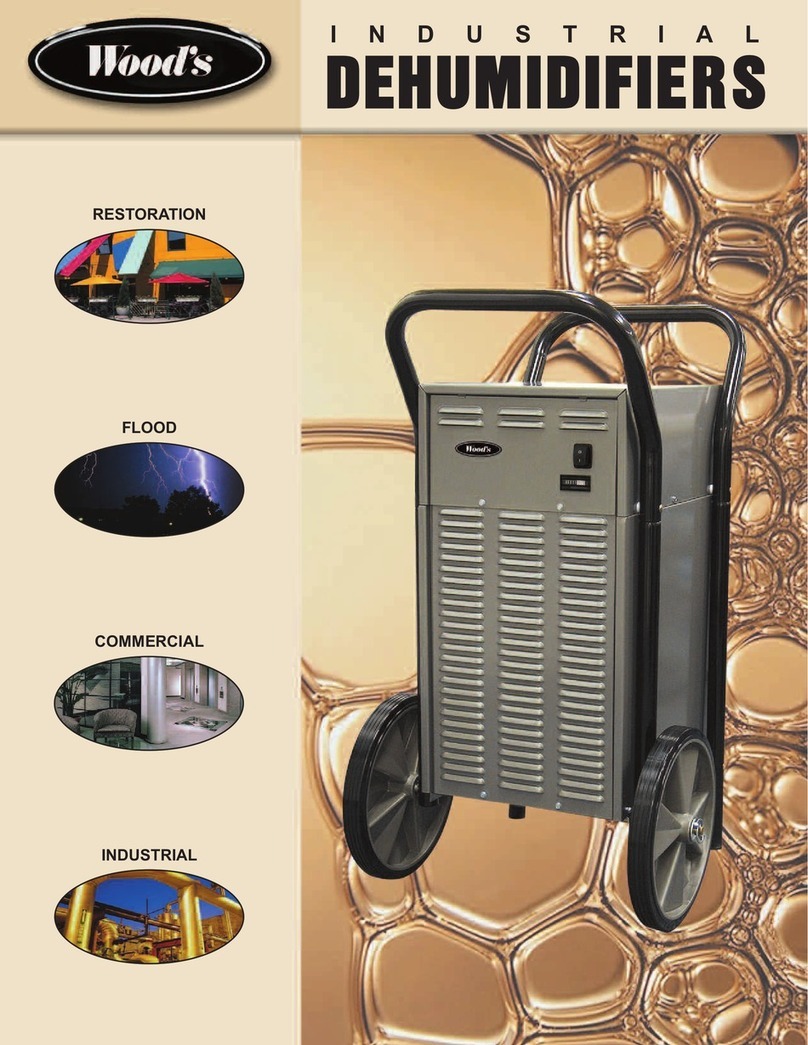
WC Wood
WC Wood WDC124C Specifications

Klarstein
Klarstein 10030040 manual
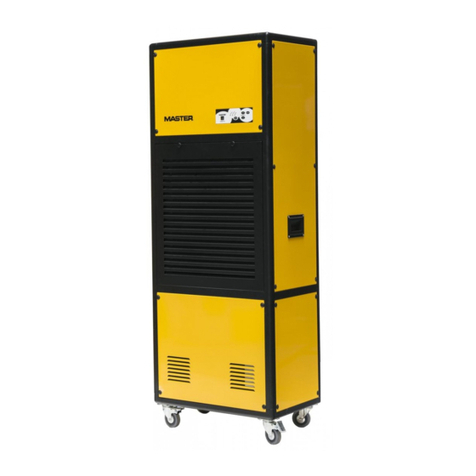
Master
Master DH 7220 User and Maintenance Book
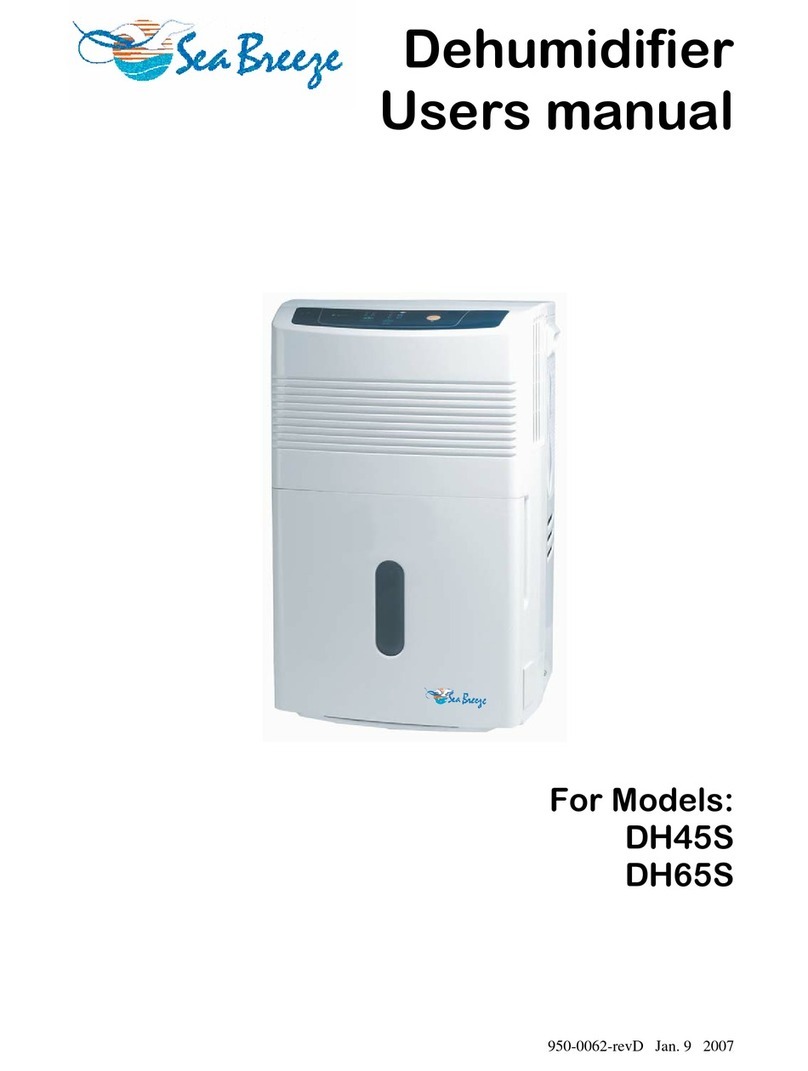
International Refrigeration Products
International Refrigeration Products DH45S user manual
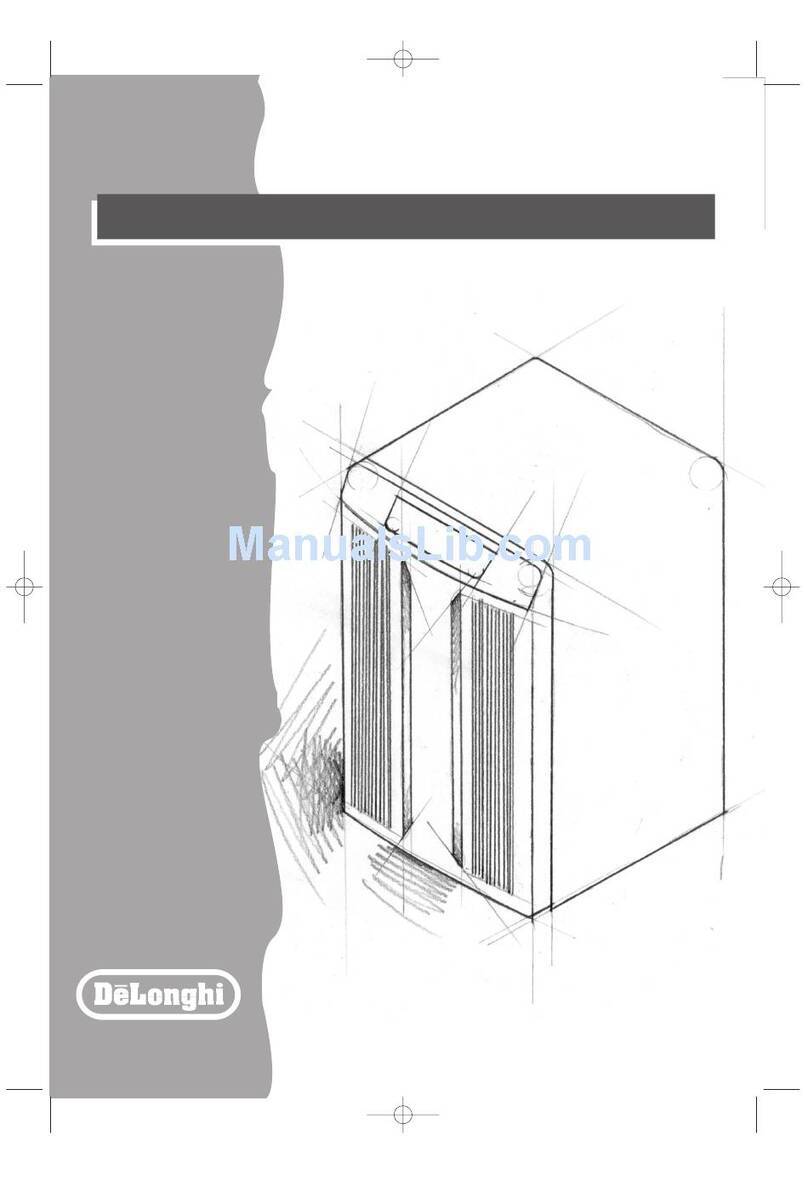
DeLonghi
DeLonghi 40EDDH30 Use and maintenance manual
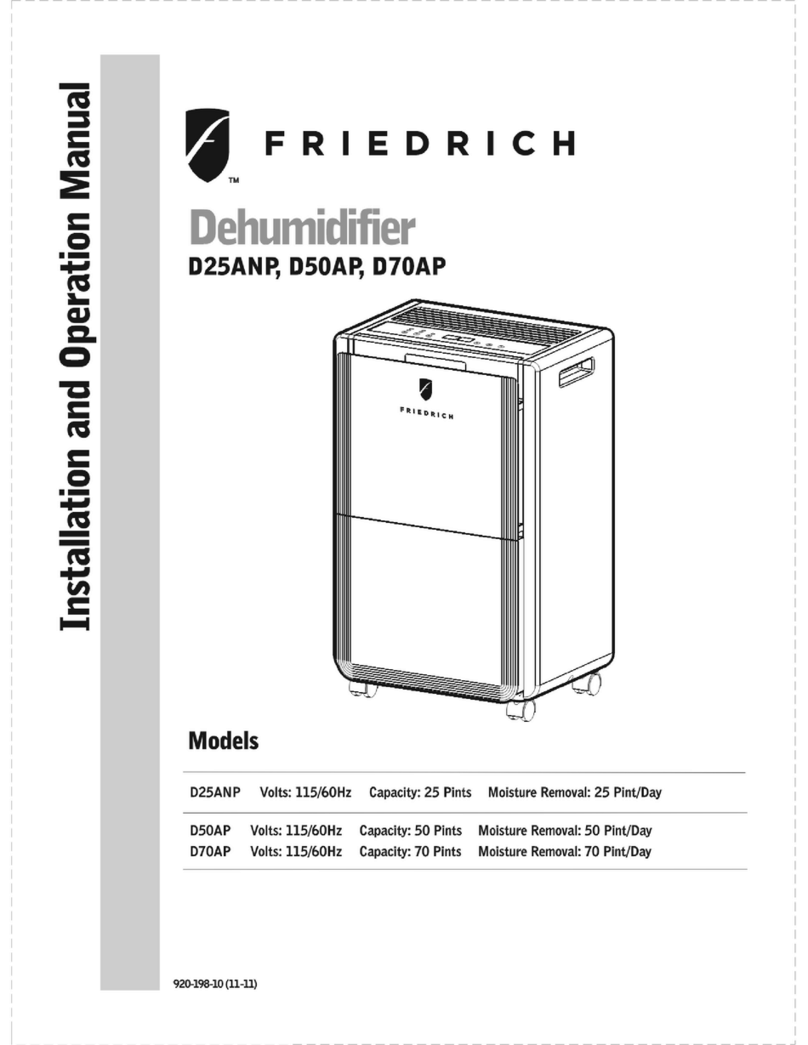
Friedrich
Friedrich D25ANP Installation and operation manual
